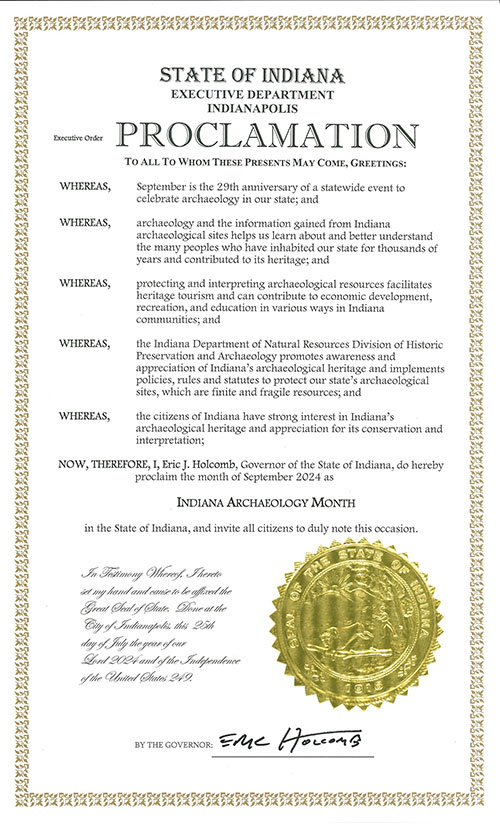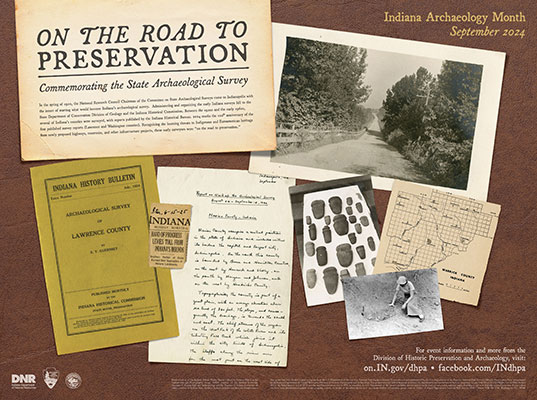Archaeology Month
- Historic Preservation & Archaeology
- Public Outreach
- Current: Archaeology Month
September is Indiana Archaeology Month. The Division of Historic Preservation & Archaeology (DHPA) coordinates the event to encourage learning about Indiana archaeology. Universities, museums, organizations, and individuals throughout the state host a variety of programs. These can include archaeological laboratory open houses, artifact identifications, lectures on archaeological topics, archaeological excavations, and more.
Archaeology Month helps Hoosiers learn more about the discipline of archaeology, Indiana archaeological sites, and laws protecting those sites. A goal of this month is to increase public awareness and to minimize myths and misconceptions commonly associated with the science.
Information for Event Hosts
The Division of Historic Preservation and Archaeology will produce and distribute a press release regarding Indiana Archaeology Month. Other avenues of publicity utilized by the DHPA include: e-mail, the DHPA and DNR Facebook pages, and the Preservation at the Crossroads e-newsletter.
The DHPA Calendar of Events webpage will post the complete calendar of events taking place around the state. Event hosts may refer the public to this page for information about the Month.
Event hosts are encouraged to cultivate as much local publicity for their events as possible. We suggest contacting local papers, radio stations, etc. for possible advertising options.
The DHPA has many educational materials available free of charge. If event hosts wish to have any of these items to help with publicity, or to hand out during the event, feel free to download as many as you like. Postage costs will be charged if physical copies are needed. Payment must be received prior to mailing any items.
If possible, we request that after Archaeology Month, event hosts provide the Division with summary information regarding their events. Information such as attendance numbers, comments regarding activities, suggestions for future events, etc. is very helpful for the Division staff to learn about and improve upon the continuing successes of Indiana Archaeology Month and public archaeology outreach.

Archaeology Month Poster
The poster theme this year commemorates the State Archaeological Survey. In the spring of 1920, the National Research Council Chairman of the Committee on State Archaeological Surveys came to Indianapolis with the intent of starting what would become Indiana’s archaeological survey. Administering and organizing the early Indiana surveys fell to the State Department of Conservation (now known as the DNR), which then had a Division of Geology, and the Indiana Historical Commission. Between the 1920s and the early 1960s, several of Indiana’s counties were surveyed, with reports published by the Indiana Historical Bureau. This year marks the 100th anniversary of the first published survey reports (Lawrence and Washington counties). Recognizing the looming threats to Indigenous and Euroamerican heritage from amateur archaeology excavations, newly proposed highways, reservoirs, and other infrastructure projects, these early surveyors were “on the road to preservation.”
We are proud the DNR was there at the beginning of the State Archaeological Survey, and that today the DNR’s DHPA continues to lead statewide efforts to protect and preserve Indiana’s Native American and Euroamerican heritage.
Free posters (folded and unfolded) will be available to pick up in person at the DNR Central Office lobby in the Indiana Government Center South complex in Indianapolis from 8:30 a.m. to 4 p.m., Monday through Friday. When attending Archaeology Month events, DHPA staff will also have posters to distribute. Requests for folded posters (limit of 5 per person) to be mailed may be sent to dhpaconnect@dnr.IN.gov.
For details on poster imagery, see 2024 poster details below.
Download poster (PDF)
- 2024 Poster Details
The Division of Historic Preservation & Archaeology thanks the following for permission for use of images in the poster design:
Road- courtesy of the Indiana Album: Harley Sheets Collection; Frances Martin at the Yankeetown site- Photographic Image N3383 courtesy of the Indiana University Museum of Archaeology and Anthropology and the Trustees of Indiana University; all others courtesy of Indiana State Archives, Indiana Archives and Records Administration.
The poster theme this year commemorates the State Archaeological Survey. In the spring of 1920, the National Research Council Chairman of the Committee on State Archaeological Surveys (CSAS), Clark Wissler, Ph.D., came to Indianapolis with the intent of starting what would become Indiana’s archaeological survey. Administering and organizing the early Indiana surveys fell to the State Department of Conservation (now known as the DNR), which then had a Division of Geology, and the Indiana Historical Commission. The general goal of the survey was described at the time as being undertaken with the view of making a careful study, county by county, of the state’s archaeological and historic material.
Between the 1920s and the early 1960s, several of Indiana’s counties were surveyed, with reports published by the Indiana Historical Bureau. This year marks the 100th anniversary of the first published survey reports (Lawrence and Washington counties). The cover of the Lawrence County publication is featured in the design, and a map of Warrick County, from that county’s report, is also shown.
Recognizing the looming threats to Indigenous and Euroamerican heritage from excavations of archaeological sites by amateur societies, newly proposed highways, reservoirs, and other infrastructure projects, these early surveyors were “on the road to preservation.” The Hoosier backcountry road shown is typical of the roads early surveyors would have traveled.
A 1925 headline from an Indianapolis Star news article illustrates the concerns regarding development at the time. Of course, a large-scale project to identify archaeological sites requires coordination, research, and fieldwork. The period records, such as the handwritten documents, provide fascinating insights into the research efforts, methods used, costs, and other challenges that were faced.
Excavations, particularly of sites that were threatened by development, were a component of the early surveys, as illustrated in the photograph of Frances Martin in 1950 at the Yankeetown site in Warrick County. While Martin was a nonprofessional, her work in Indiana archaeology exemplified the role of the State survey to increase and enlist relations with nonprofessionals with interests in Indiana’s archaeological record. In addition to enlisting the assistance of nonprofessionals, surveyors would routinely examine and document private collections of artifacts, as shown in the photograph of the ground stone axes. Because of the dearth of professional archaeologists working in the Midwest in the 1920s, the CSAS sought to professionalize archaeology by working with both professionals and amateurs. The CSAS distributed pamphlets defining what constituted a state archaeological survey, aims and methods and guidance for amateur archaeologists, and organized three conferences, one of which was held in Indianapolis in 1935. Between the 1920s and 1960s the course of professional archaeology survey in Indiana was charted by a number of early historians, geologists, amateurs, and trained archaeologists including E.Y. Guernsey, Frank Setzler, Fred Eggan, Glenn A. Black, Willliam R. Adams, Don Dragoo, Charles Faulkner, Hilda J. Curry, and James Kellar, among others.

